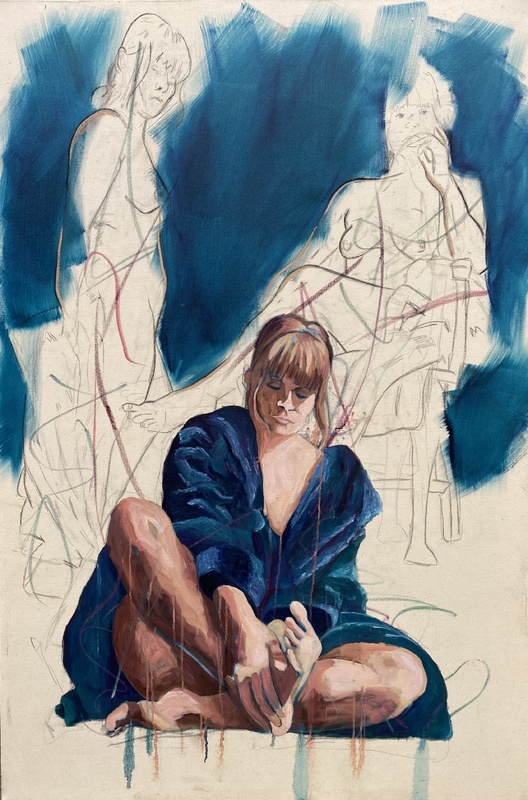Rae George North Yorkshire, United Kingdom
Through painting, I share my experiences as a woman artist in my mid 30’s. I tackle issues like mental health, love, and pressures of being a woman in today’s society. I do this inspired by art history and particularly focus on the subject of the self.
Through painting, I share my experiences as a woman artist in my mid 30’s. I tackle issues like mental health, love, and pressures of being a woman in today’s society. I do this inspired by art history and particularly focus on the subject of the self. ‘The Maker, The Model and The Muse’ is the outcome of this research. The body of work is approached by a female artist from a female point of view but also challenges the male gaze, a term coined by film critic Laura Mulvey back in 1975. ‘It refers to the presentation of women in visual arts and literature from a male, heterosexual perspective where women are depicted as sexual objects for the pleasure of the male viewer. Men have agency; women are passive and dehumanised.’ (Frisby, 2020). Through encountering my work, I aim to show the female figure from a female gaze, a responsive theory to Mulvey coined in 1985 by Bracha L. Ettinger. Also the female experience to make the viewer better understand that women are not what a patriarchal society has deemed us. Feminine should in my view, no longer be set by heterosexual, white, male standards. I was recently asked, by a man, how does it feel when men look at my work of me naked? This proved the theory that the female body has traditionally, subconsciously and without question been the subject of men for far too long. By using a masculine sounding name, Rae George, and showing the popular subject of the female body I am hoped to question the institutional sexism and traditional patriarchal mindset and to change the way women are thought of as artists. In 1989 the Guerrilla Girls asked ‘Do women have to be naked to get into the Met Museum?’ Less than 5% of the artists in the Modern Art Sections are women, but 85% of the nudes are female.’ (Guerrilla Girls, 1989) further investigation shows that these figures have not changed much. In 2021 at the Met Museum women made up ‘Less than 10% of the 169 artists exhibited their work.’ (Merton, 2021)
I question ideas of masculinity and femininity, thinking about how these interwind and play their part in both men and women. In his 1893 novel An Ideal Husband, Oscar Wilde wrote ‘Ah! the strength of women comes from the fact that psychology cannot explain us. […] Science can never grapple with the irrational.’ (O Wilde, 1893) Being feminine has been seen as a weakness in society possibly for this reason. But, when we encounter Sigmund Freud who stated ‘In human beings pure masculinity or femininity is not to be found either in a psychological or biological sense.’ (Sigmund Freud, 1962) we can question the idea of lack of power in the feminine further. The journey to my major body of work started with the feeling of vulnerability. At the end of my first year of study I had gone through a breakup and life changed drastically. I felt exposed and vulnerable but at the same time free and that anything was possible. I began producing unclothed self-portraits in a series called ‘Rae-naissance’, to show my raw and exposed nature and the feeling of re-birth, through this work I could take control of what I felt and how I was viewed.
























